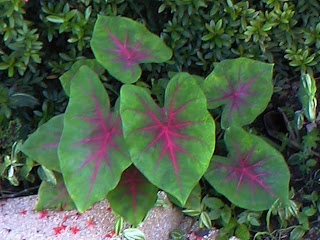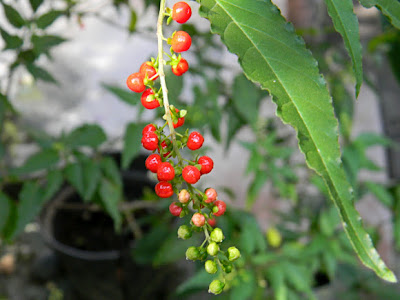Description Perennial herb, sometimes woody at the base, 300-900 mm high
with spreading branches; finely hairy when young. Leaves light green, thin
textured, ovate to ovate-elliptic, on long slender petioles. Flowers, white or
greenish to rosy, small, in slender, loose, many-flowered racemes. Flowering
time from October - June or all year. Fruits, glossy, bright red berries, with
one hairy seed per fruit. a species of flowering plant in the pokeweed family,
Phytolaccaceae, that is native to the Americas. It can be found in the southern
United States, the Caribbean, Central America, and tropical South America.
Common names include Pigeonberry, Rouge.
Herbaceous bushy perennial standing up to 120cm (4ft), sometimes woody at
base; leaves ovate to oblong, thin, to 3-10cm (1-4in) long, petioles slender;
racemes slender, loose, to 20cm (8in) long and have wavy margins; flowers pink
to white flowers grow on a spike measuring 3-5cm (1-2in) in length; the top of
the spike has reddish-pink buds and the base has bright red to orange fruit, 5mm
in diameter. Rivina humilis blooms from May to October. Grows well in the
Caribbean and tropical America.
Distribution Native to North, Central and South America and West Indies. It
is widely naturalized in Indo-Malesia and the Pacific Islands. In Australia it
invades rainforest margins and shady places and in other islands like Fiji, it
occurs in coastal areas and along roadsides. Rivina humilis
Habit at Ualapue, Molokai - Credit: Forest and Kim Starr - Plants of Hawaii
- Image licensed under a Creative Commons Attribution 3.0 License, permitting
sharing and adaptation with attribution.
How it Spreads
Bloodberry spreads mainly by seed. The attractive bright red
colour of the seeds makes the rivina a choice food for many kinds of birds which
allows seeds to be easily dispersed. For small infestations, seeds can be
collected and destroyed. Plants with no seeds can be hand-pulled and hung up to
dry. Seed heads can be removed to minimize new growths. Ideally control should
be done before the plants have the chance to form berries and/or flowers. There
are no herbicides registered for this plant in South Africa. Rivina humilis
Flowers fruit and leaves at Ocean Ridge Hammock Park, Florida - Credit:
Forest and Kim Starr - Plants of Hawaii - Image licensed under a Creative
Commons Attribution 3.0 License, permitting sharing and adaptation with
attribution.
History in South Africa Blood berry was introduced to South Africa as an
ornamental. The earliest record is a specimen in Pretoria National Herbarium
collected in 1944 at Lower Tugela in Stanger, KwaZulu-Natal and in 1946 at
Queens Park in East London, Eastern Cape. Its color comes in the form of soft
pale pink flower spikes followed by bright red berries, often with several
clusters of each covering the plant. The berries are loved by birds and deer
seem to leave the plants alone as well. If Pigeonberry is not watered during
extreme drought it may go dormant and return later. Other names for this plant
are, Rouge Plant and Baby Peppers though it isn't edible.
Environmental and economic impacts Bloodberry is a dwarf-like plant hence
the species name humilis, and is shade tolerant. It threatens plants that grow
at lower altitude in forests. Following disturbance of natural vegetation, this
plant interferes with the re-establishment of native forest vegetation as it
forms dense monocultural stands. All parts of the plant are poisonous,
especially the leaves. Although birds will eat the berries, they are somewhat
poisonous to humans.
Stem
Usually flowers and fruits as a shrub about 1 m tall but can flower and
fruit when much smaller.
Leaves
Leaf blades about 4-12 x 1.5-4 cm, petioles about 1-3.5 cm long. Leaf blade
quite thin, wilting quickly when picked. Twigs glabrous, longitudinally grooved,
rather pithy. Scattered pale-coloured hairs usually present along the midrib on
the underside of the leaf blade. Petiole with two rows of glandular hairs on the
upper surface.
Flowers
Racemes erect, glabrous, about 4-12 cm long, pedicels about 2-3 mm long
at anthesis, subsequently elongating. Tepals about 2-2.5 mm long, glabrous.
Anthers glabrous.Ovary subglobose, glabrous, style short with an extension
running down the side of the ovary.
Fruit
Fruits bright red, about 3.5-4 mm diam. Testa brown, surface hairy. Embryo
horseshoe-shaped, surrounding a central pocket of endosperm, cotyledons rolled
longitudinally like a cigar.
Seedlings
Cotyledons orbicular to almost cordate, glabrous, about 9-11 mm diam,
petiole about 8-10 mm long, almost as long as the cotyledon. At the tenth leaf
stage: leaf blade lanceolateor broadly lanceolate, petiole almost as long as the
leaf blades. Upper surface of the petiole, near its junction with the leaf
blade, densely clothed in short, glandular (?) hairs.Petiole grooved on the
upper surface.
Distribution and Ecology
An introduced species originally from tropical America, now naturalized in
CYP (Torres Strait Islands), NEQ and southwards as far as north-eastern New
South Wales. Altitudinal range from near sea level to 900 m. Usually a weed
associated with man-made or modified vegetation types but also grows in
disturbed areas in lowland and upland rain forest and monsoon forest. Also found
in closed vegetation types near the sea. Also occurs as a pantropic weed.
By cultivation it has been distributed through not only all tropical and
subtropical regions, but also in many of the temperate countries of the globe.
The valuable purgative known as castor oil is the fixed oil obtained from the
seeds of the castor oil plant. Besides being used medicinally, the oil is also
employed for lubricating purposes, burning and for leather dressing.
It is very variable in habit and appearance, the known varieties being very
numerous, and having mostly been described as species. In the tropical latitudes
most favourable to its growth, it becomes a tree 10-12m (30-40ft) high.
The handsome leaves are placed alternately on the stem, on long, curved,
purplish foot-stalks, with drooping blades, generally 12-18cm (6-8ins) across,
sometimes still larger, palmately cut for three-fourths of their depth into
seven to eleven lance-shaped, pointed, coarsely toothed segments. When fully
expanded, they are of a blue-green colour, paler beneath and smooth; when young,
they are red and shining. The flowers are male and female on the same plant, and
are produced on a clustered, oblong, terminal spike. The male flowers are placed
on the under portion of the spike; they have no corolla, only a green calyx,
deeply cut into three to five segments, enclosing numerous, much branched,
yellow stamens. The female flowers occupy the upper part of the spike and have
likewise no corolla. The three narrow segments of the calyx are, however, of a
reddish colour, and the ovary in their centre is crowned by deeply-divided,
carmine-red threads - styles.
The fruit is a blunt, greenish, deeply-grooved capsule less than an inch
long, covered with soft, yielding prickles in each of which a seed is developed.
The seeds of the different cultivated varieties differ much in size and in
external markings but average seeds are of an oval, laterally compressed form.
The smaller, annual varieties yield small seeds- the tree forms, large seeds.
They have a shining, marble-grey and brown, thick, leathery outer coat, within
which is a thin, dark-coloured, brittle coat. A large, distinct, leafy embryo
lies in the middle of a dense, oily tissue (endosperm).
Description: The flowers are in slender terminal racemes. The individual
flowers are small and have 4 rounded, pink, white, or green sepals. The round,
red berries contain a red dye and are often present at the same time as the
flowers. The leaves are green, petiolate, and ovate, lanceolate, or triangular
in shape. The stems are slender.
Special Characteristics
Poisonous – The entire plant is poisonous, especially the leaves. Although
birds will eat the berries, they are also somewhat poisonous to humans.
























